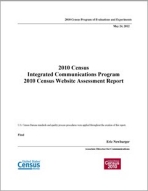2010 Census Integrated Communications Program 2010 Census Website Assessment Report
2010 Census Integrated Communications Program 2010 Census Website Assessment Report
Executive Summary
The 2010 Census Website page was implemented by the Census 2010 Publicity Office and was the center for the integration of the entire 2010 Census Communications Campaign. Programs as diverse as Census in Schools, the Road Tour, and Partnerships all delivered content to their constituents via the 2010 Census website - 2010Census.gov – and it continues to provide value to the Census Bureau as a release vehicle for the 2010 Census results. This post-campaign use represents a significant expansion of the original vision of the website.
This website was created in an expedited m nner from June 2009 through October 2010. This assessment will show that this rushed effort was ultimately successful and even award winning although it was challenging to implement. The goals of this assessment will be to document the difficulties this late start created, as well as the successes the Census Bureau achieved.
In creating the 2010Census.gov website, the Census Bureau referenced the Census 2000 communications program, which had been credited for helping to reverse a three-decade decline in the mail response rates and also to reduce the differential undercount for historically undercounted population groups. However, with the in creasing prevalence of the Internet in the United States combined with corresponding changes in public expectations for both the quality of online content and the ways of interacting with that content, digital media presented both new opportunities and new challenges in the 2010 Census.
New technologies, in particular social media, were used to reach segments of the population that had previously been difficult to reach. It has become a major means of correspondence in the nation, which allows us to quickly publish and disseminate documents of all sorts such as tool kits, press releases, talking points, brochures, pamphlets, study guides, videos, audio recordings, still photos, and data maps at a low cost. Furthermore, the Census Bureau could put all these documents in the same place, making it easy for people to find what they needed. The 2010 Census website allowed us to instantly transmit to all of our audience segments via this one channel.
Given the central role for 2010 Census website, it was unfortunate that the web team formed so late in the campaign timeline. This required a compressed development schedule that naturally resulted in some difficulties. For example, had the Census Bureau been able to user-test the marquee prior to launch, the Census Bureau would likely have discovered the problems with its interface and corrected them. Had the web team begun earlier, the Census Bureau could have fully integrated the Census in Schools and Jobs webpages into the rest of the site. Our social media efforts, while successful, would likely have been more successful, since social media promulgates via a grass-roots growth, which requires time to mature.
The Census Bureau made considerable use of the internet for the 2010 Census Communications Campaign, with many successes and some failures. If the Census Bureau takes more time to plan our efforts for the 2020 Census, the Census Bureau should be able to avoid repeating mistakes, while making even greater use of this new and pervasive communications tool. Based on the results of this assessment, there are four prominent Lessons Learned and Recommendations:
- The web has become a major communications medium in the United States, and it should be critical to the 2020 Census;
- The web allows for targeting messages to disparate audience segments to a degree beyond that offered by traditional media, and this contributed to the integration of the 2010 Census Communications Campaign. Future campaigns, bolstered by more detailed audience segmentation models may benefit from additional investment in this targeted medi;
- Presuming the 2020 Census adheres to a schedule similar to the 2010 Census, the Census Bureau should begin the 2020 Census web effort should begin planning, design, coding of test pages, and most importantly user testing by 2016 at the latest, to allow early parts of the census campaign (such as the hiring of enumerators) to benefit from the web strategy.
- Using sources outside the Census Bureau to create the website was challenging. Intimate knowledge of Census Bureau datasets and methods of operation had to be provided to people with no significant background in the subject matter. The 2020 Census web effort should allow the Census Bureau to develop an internal staff capable of building the kinds of tools the Census Bureau will use without using outside contractors for programming.
Others in Series
Publication
Publication
Publication




